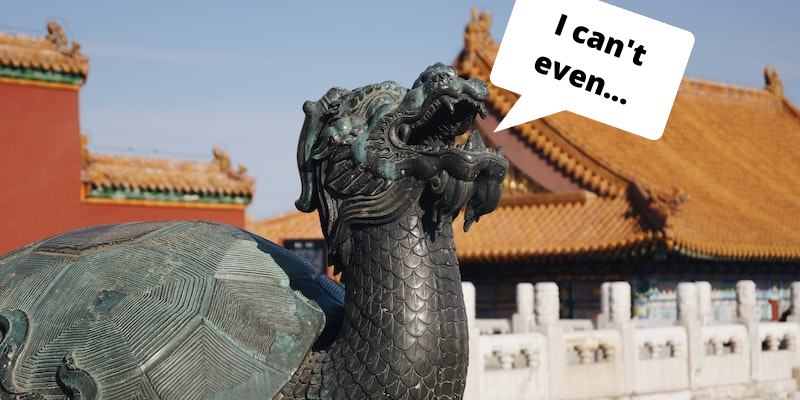...and trampled over Chinese culture.
And here I am thinking Chinese culture involves trampling and scootering over innocent pedestrians. Silly me.


Throwback Thursday takes a look back into Beijing's past, using our 12-year-strong blog archives as the source for a glance at the weird and wonderful stories of Beijing's days gone by.
As 2020 comes to a close, so too does the 600th anniversary of Beijing’s most popular tourist attraction, the Forbidden City. And as is the case with anything that has six centuries of history under its belt, the sprawling imperial complex has not been without its fair share of scandals and controversies. So, in light of both the anniversary and the end of the year, we figured we’d use this Throwback Thursday to wish our beloved Old Palace one last happy birthday by giving it a good old fashioned roast and dredging up some of its more questionable moments from recent memory.

This controversy was actually seven years in the making, as Starbucks initially opened its Forbidden City branch in 2000. However, it came to a fever pitch in 2007 when Rui Chenggang, an anchor for CCTV’s English-language division started an online campaign to get the global coffee chain booted from the imperial enclave. Writing on his official CCTV blog at the time, Rui argued that Starbucks’ presence “undermined the Forbidden City’s solemnity and trampled over Chinese culture.” Interestingly, Starbucks actually took up residence at the behest of Palace managers, who were hoping to generate some capital for general upkeep. Apparently, however, you can’t put a price tag on hundreds of years of history and culture, and Rui’s campaign got enough people crying “Sell out!” to see the world-famous beanery pack up and move.

Eight years after Starbucks’ scantily-covered siren logo left the Imperial court, a new scandal of even scantier-covered proportions emerged when a photographer going by the Weibo handle, WANIMAL, decided to shoot a woman wearing no more than an emperor’s consort making an evening call. To be sure, the photoshoot took place undetected, and it wasn’t until the images started making their way around social media that folks began to weigh in, albeit with what seems to be a lot less outrage than Starbucks was faced with. According to a China Daily article from the time, “After the photos emerged online, some internet users questioned whether it was proper to take naked images in a historic site.” Proper? Maybe… maybe not… we don’t feel it’s our place to weigh in on that. But is it illegal? Kind of? According to Chinese law, folks can expect to face a mere five to ten days in detention for exposing themselves in public. Seems like a small price to pay in the service of art. Nevertheless, we wouldn’t suggest you go skinny dipping in Houhai or streaking through the Summer Palace any time soon.

Unfortunately, it would be but a little over a year before the Forbidden City found itself mired in the gossip pages again, this time for supporting a mobile phone that cost a whopping RMB 19,999. The smartphone in question, 8848 Phones’ luxury Titanium Palace Edition was initially announced in May 2016 with the full support of the Palace Museum itself. At the time, Wang Yamin, vice-president of the Palace Museum said of the project, “We hope this cooperation will help the Forbidden City enter the tech industry.” It wasn’t until December of that year, however, that full specs of the phone – a limited production run of 999 units, a sapphire glass covering on the front, and an 18-carat gold dragon medallion surrounded by lambskin on the back – were released alongside images, that it was deemed a “royal disgrace” on social media, with Weibo users declaring it “ostentatious” and a “stain on the sacredness of the imperial city,” ultimately leading the Palace Museum to tersely state on their own Weibo account, “We don’t sell mobile phones.” Perhaps someone should’ve told Wang this back in May.
Incidentally, this wasn’t the first phone-related scandal to hit the Forbidden City. That title goes all the way back to 1921 when the then 15-year-old emperor Puyi demanded that the Palace install his own landline. After much debate, his advisers finally relented, and Puyi got the phone, which he subsequently used to make prank calls. You can read all about it right here.

And lastly, we come to January of this year when two women drove a Mercedes-Benz SUV onto Palace grounds to snap a few Weibo-worthy shots. This was during the early days of the coronavirus outbreak, and though the iconic site hadn’t yet shut its doors for that reason, it did happen to be a Monday, when the Forbidden City is closed for routine maintenance. The perpetrator, Lu Xiaobao, quickly deleted the photos after netizens rebuked her stunt, however, the initial post read, “On Monday the Palace Museum is closed, so I hurried over, hid from the crowds and went to play in the Forbidden City.” As they say, it’s all fun and games until someone gets hurt, and in this case, that which got hurt was the pride of a nation, with one user saying, “Deleting the pictures is useless; the entire Chinese nation has seen them.” In response, the Palace Museum said it was “deeply distressed and sincerely apologizes to the public.”
READ: Throwback Thursday: The End of a "Freelancer’s" Free Rein
Images: Gigi (via Unsplash), PRactical Global Relations, Weibo, Gizmo China, CCTV
If you are interested in joining True Run Media, please feel free to contact our team.